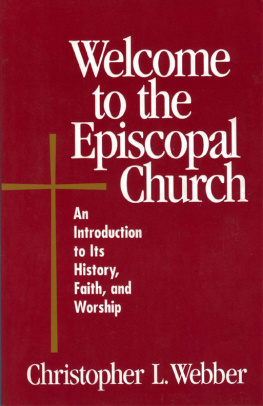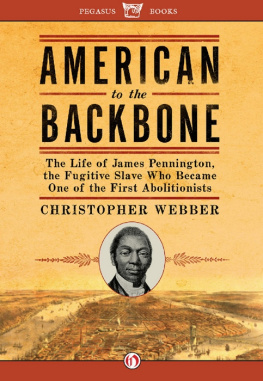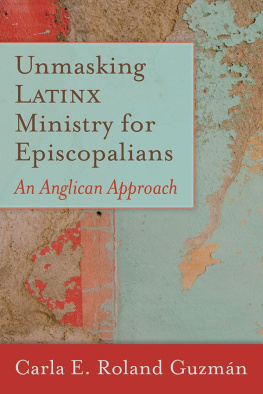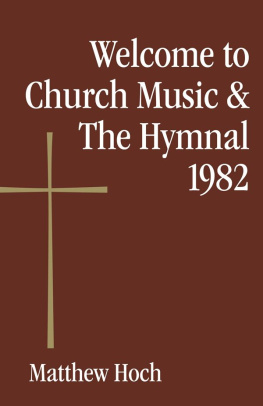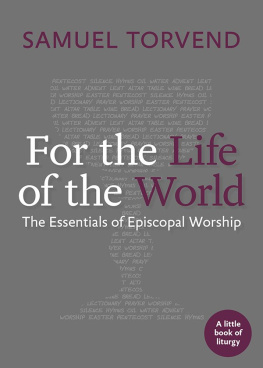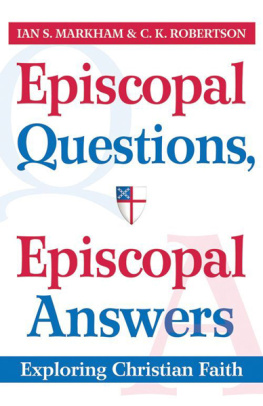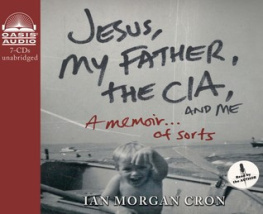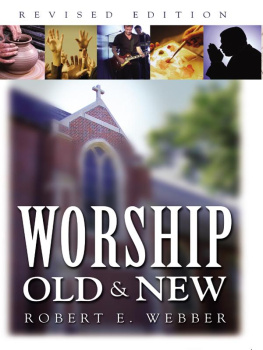
Welcome to the
Episcopal Church
Welcome to the
Epscopal Church
An Introduction
to Its History,
Faith, and Worship
Christopher L. Webber
Foreword by
The Most Reverend Frank T. Griswold III
Presiding Bishop and Primate

Copyright 1999 by Christopher L. Webber
Morehouse Publishing,
4775 Linglestown Road,
Harrisburg, PA 17112
Morehouse Publishing,
445 Fifth Avenue,
New York, NY 10016
Morehouse Publishing is an imprint of Church Publishing Incorporated.
www.churchpublishing.org
All rights reserved. No part of this book may be reproduced or transmitted in any form or by any means, electronic or mechanical, including photocopying, recording, or by any information storage and retrieval system, without written permission from the publisher.
Unless otherwise noted, Scripture quotations contained herein are from the New Revised Standard Version Bible, copyright 1989 by the Division of Christian Education of the National Council of the Churches of Christ in the U.S.A. Used by permission. All rights reserved.
Cover design by Corey Kent
Library of Congress Cataloging-in-Publication Data
Webber, Christopher.
Welcome to the Episcopal Church: an introduction to its history, faith, and worship / Christopher L. Webber ; forward by Frank T. Griswold III.
p. cm.
Includes bibliographical references.
ISBN 978-0-8192-1820-9 (pbk.)
ISBN 978-0-8192-2520-7 (E-book)
1. Episcopal Church. I. Title.
BX5930.2 .W43 1999
Contents
Foreword
Most Episcopal churches have a sign saying, The Episcopal Church Welcomes You, and certainly the clergy and laity of parishes do their best to welcome those who come to services for the first time. Episcopalians, on the whole, are very friendly people. We love to show hospitality to those who come for a visit, and we hope they will return. We do this also because we believe that hospitality to a guest is one small sign that we can make of the much more generous hospitality that God shows to those seeking to know the risen Christ.
Christopher Webber has written a helpful introduction to the history, faith, and worship of the Episcopal Church which will be one more way we can make newcomers welcome to our church. It will also be useful to those already active in our church community.
The author writes from the perspective of scholar, teacher, overseas worker and pastor of a variety of churches as he tells the story of the Episcopal Church: who we are, where we have come from, what we believe, and how we worship God. What especially pleases me is that the book makes clear that the worship of God is the most important thing that can be said about us, and that worship is the source for everything else in our life togetherour commitment to justice for all people, our mission to those who do not yet know Jesus Christ as their Lord and Savior, and how we should live out our lives in this very complex world.
Being a Christian, in fact being a religious person at all, is not easy in our present society. All of us are pulled in many directions. This book makes it clear that the Episcopal Church does not offer any final or absolute answers to the conflicts in ourselves or in our society. It does, however, affirm that as a community grounded in prayer and worship, we are seeking to know Gods will and, by the grace of God, to do God's will in all the areas of human concern that are the responsibility of those of us who believe in Jesus Christ.
It is obvious that this book has come from one who, over the years of his pastoral leadership, has seen the need for study and growth to achieve a fullness in Christ. I hope that you who read it will gain a better understanding of the Episcopal Church and a fuller knowledge of our faith community.
The Most Reverend Frank T. Griswold III
Presiding Bishop and Primate
Preface
There is probably no church sign more often seen and widely recognized on American streets and highways than the one that says, "The Episcopal Church Welcomes You." Perhaps it was even one of these signs that brought you to the Episcopal Church. But whether you have been sitting in the pews for many years or are new in the last few weeks or months, the sign is true: The Episcopal Church welcomes you.
Being welcoming, of course, is not just a matter of a warm greeting from an usher or a friendly reception at the coffee hour. Part of the process of hospitality is learning each other's stories. As you meet people in the coffee or Christian Education hours, or in committee meetings or church activities, you will probably begin to tell people a little about who you are, how you came here, and what you believe. You may even begin to explore and share your own deeply held beliefs about prayer, the Bible, and God. Engaging in these conversations will help make the Church into "home" for you. These same conversations will also be an important part of your growth and participation in this community.
Another part of your journey in the Church is learning its stories: where it came from, what it believes, how it worships, how it understands the Bible and God, how it reaches out to the rest of the world. Many of these stories are contained in this book. Some of them may have much in common with your own story, and may help you understand why you were drawn here, and how your story might become a part of the larger story. One thing you will notice right away, however, is that our history, beliefs, and even our governing structure take a variety of perspectives and voices into account. The words "inclusive" and "diverse" appear often in the mission statements of individual Episcopal parishes, as well as in the materials from our national offices. Episcopalians value what is revealed about God and God's will in the continuing conversation among people of a variety of perspectives. It is why our signs say: "The Episcopal Church welcomes you." I hope you enjoy the conversation!
It would be hard for any single individual to capture the diversity of the Episcopal Church in writing. No single individual could experience in a lifetime the varieties of ways in which the Anglican vision is lived out in thousands of parishes spread across the country and around the world. I have been greatly helped, however, by the careful reading and suggestions of a number of individuals, among them Debra Farrington, Donald Hamer, Margaret Webber, Brother Randolph Horton, and the Revs. G. Scott Cady, Hope Eakins, William Gregg, and Daniel Hardy. They have helped me describe the Episcopal way of life more accurately, though not always, I must admit, as they might have described it themselves. The final balance, accurate or not, remains my own. But this book is intended only as in introduction and starting point. Finally, each individual will need to make a personal investigation and arrive at his or her own understanding. There is much more alwaysfor each of us to find.
History
BEGINNINGS
When a baby is born, the grandparents and cousins and friends will come to admire the new member of the family and someone will say, Isnt she the very image of Great-aunt Abigail! or, Doesnt he look just like Uncle Fred? For better or worse, we inherit many of our characteristics from our ancestors. Churches, like people, are shaped by their past.
But how far back must we go to understand the Episcopal Church? As members of an American church, we need to know what happened in the colonial period and Revolution, but as inheritors of a European tradition, we cant avoid dealing with the churchs English heritage also. Finally we will need to go still further back and understand something about the Reformation and the Middle Ages and the early church. If we had time, perhaps we should talk about Adam and Abraham! But this book is an introduction to the American Episcopal Church, so we will need to concentrate on the last few centuries of our history and take time here for only a few comments about the early church, Middle Ages, and Reformation. What we need to look for in a quick summary of our church ancestry is the common characteristics that have always been part of the churchs life and still are today. Lets begin with the Bible.
Next page
